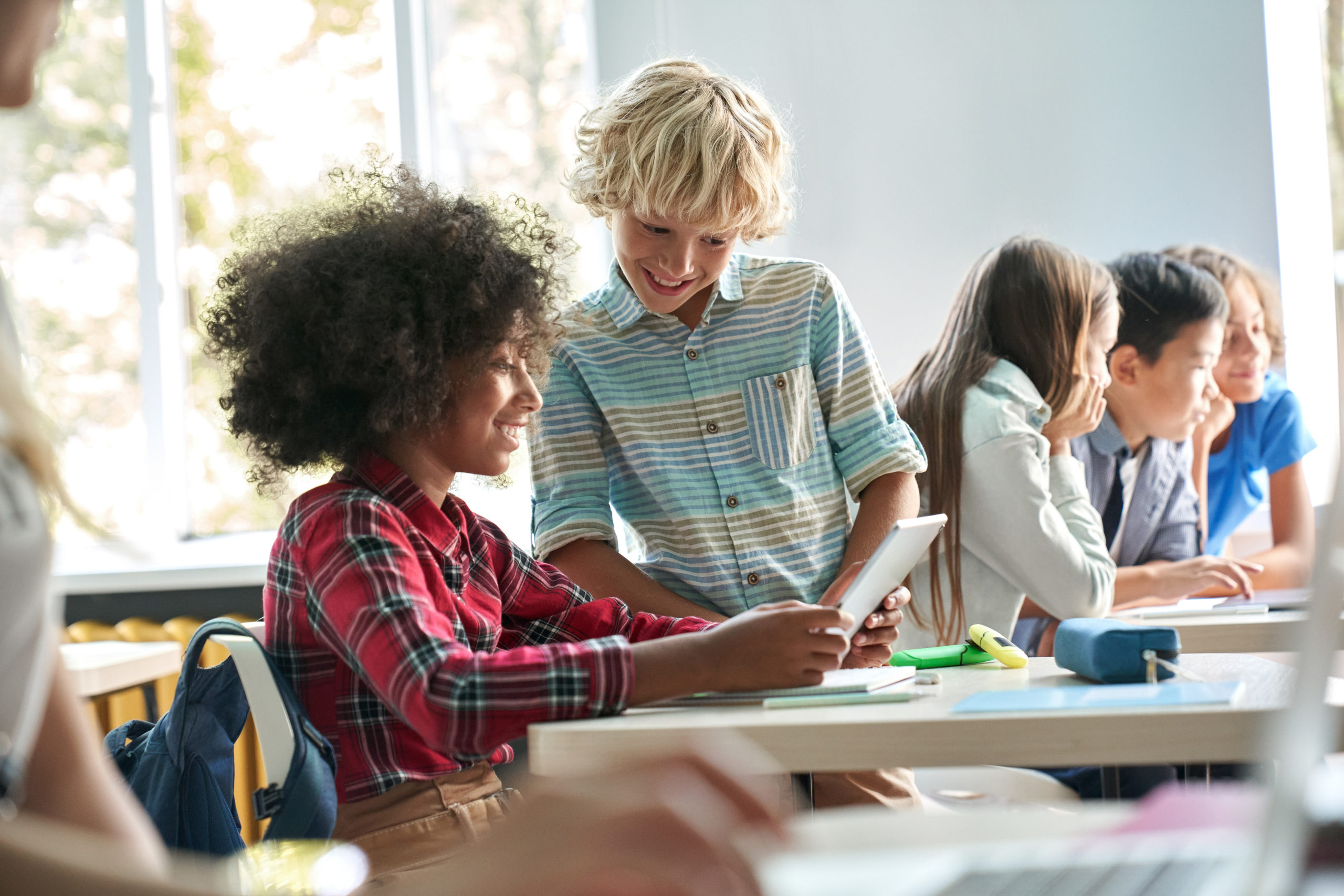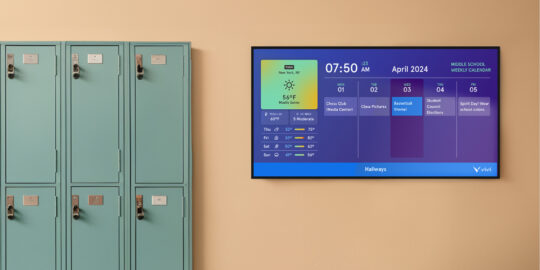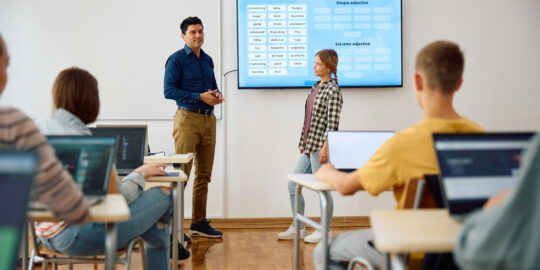
Students at all levels of education, from kindergarten to twelfth grade, are constantly using technology in their daily lives. More than half of US kids have a smartphone by the time they’re eleven. By high school, that number increases considerably.
Today’s students have come to expect technology in the classroom, and there are a number of benefits that technology can offer. Not only does using technology regularly help improve student engagement and offer them a better look at the skills they will need as they move into their future careers, but it can also offer a number of advantages for teachers, as well.
Technology in the classroom allows for greater collaboration, control, and creativity: the things teachers and students alike need in order to excel in the classroom.
Technology in the Classroom: It’s How Students Interact with the World
Today’s students are digital natives. They’ve grown up using technology, often from the time they are toddlers. Technology shapes who they are and how they interact with the world around them.
It’s how they learn, communicate and interpret their world. They communicate with their friends over technology. They know that they have access to an incredible array of information at their fingertips, all the time. They interpret the world around them through the lens of technology and expect others around them to do the same.
That means that today’s students require a unique educational approach. The methods used to teach past generations are no longer effective.
Many of today’s teachers may recall their math teachers telling them that they would “never carry a calculator around with them everywhere,” only to discover that, in fact, they now do so every day–and the same is true of many of the resources that today’s students take for granted. Furthermore, knowing how to use that technology effectively is now crucial for many students’ future career success.
By bringing technology to the classroom, many teachers find that they are able to better interact with students on their level. Technology provides them with a way to bridge the gap between students’ experience and their own–and to improve overall student engagement for a better learning experience.
The Importance of Technology for Educators
Many educators are surprised by just how many benefits using educational technology can offer in the classroom. Modern technology makes it easier than ever to share a wide variety of content with students, encouraging greater overall engagement and enhancing the learning environment.
J-PAL North America summarized 126 evaluations of different uses of educational technology and found “educational software programs designed to help students develop particular skills have shown enormous promise in improving outcomes, particularly in math.” And “Software has the potential to overcome traditional classroom constraints by customizing activities for each student.”
Clearly, when answering the question should we use technology in the classroom, the answer is a resounding yes. Here are more in-depth reasons:
1. Technology offers access to a wider range of educational materials.
Educational technology provides educators with access to many more materials than they could create on their own. Today’s instructors can find a wide range online: lessons created by other teachers, by textbook companies, and by specific apps and platforms.
Often, there is already content out there that directly addresses whatever students might be struggling with or whatever content a teacher wants to present. Technology in the classroom makes those materials highly accessible–and allows educators to share them with their students more easily. Without reliance on handouts, worksheets, or costly printed materials to share content with students, teachers can access:
- Webinar content
- Simulations that will take students directly into the learning experience
- Animations
- Electronic books and textbooks
That content is often specifically geared toward the exact type of lesson and even grade level being taught – and often, they were created by other teachers facing the same complex challenges. Many teachers are also interested in creating those materials themselves for a customized classroom experience geared directly to the needs and goals of their students.
2. Technology allows for more creative teaching strategies.
By utilizing technology in the classroom, teachers are better positioned to offer more creative lessons that will, in many cases, allow them to better reach students and increase overall engagement. They might, for example, try strategies like quiz games, integrating larger-scale projects into student learning, or providing clips, images, and videos for their students to enjoy–and that’s just the tip of the iceberg.
Many of today’s students will benefit from immersing themselves in a simulation, whether they’re dissecting a virtual frog or exploring how to create and grow their own businesses in a virtual environment. Others will find that it’s easier to retain rote information when they use quiz games and platforms to encourage memorization.
With so many options to choose from, teachers can put together more engaging lessons that will help encourage students to genuinely connect with the content in front of them. When a lesson isn’t sticking or students are struggling more than anticipated, teachers have options to pivot instruction at their fingertips–and when student interest goes beyond the lesson, teachers have access to the tools they need to support further learning.
3. Classroom technology allows teachers to customize learning based on student needs.
Technology is also ideal in classrooms with students who may have vastly different learning styles or may find themselves at dramatically different points in the learning process. By utilizing technology, teachers can provide more effective lessons for each student based on their current ability level and needs, rather than simply teaching to the classroom average.
Technology-based lessons allow for more individualization, which can help prevent students from falling behind while still providing comprehensive instruction to students who may have already moved beyond the basic concepts presented in the lesson. Teachers can place students in small groups or allow them to work individually on lessons tailored to their specific needs.
4. Technology in the classroom allows for greater overall collaboration.
Technology helps make it easier than ever for students and teachers to collaborate in the classroom–or from wherever they are. Communication is critical to an effective learning process.
Not only is technology incredibly beneficial when students and teachers cannot learn from the same location, but it can also prove essential to communication inside the classroom, too. Some students may feel more comfortable asking a quick question or calling teachers’ attention to a quick issue via chat than they are asking a question in person. Others may find it easier to share exactly what they’re working on when they’re able to show exactly where they got stuck on a device.
Technology also helps streamline collaboration on group projects and between teachers and students. Thanks to the convenience offered by technology, students can work on their own pieces of a project, then screen share, mirror, or send information to one another to make those pieces part of a more comprehensive whole.
Related: Collaborative Technology Tools for Students: A World of Possibilities
How Screen Mirroring Technology Can Add Another Layer to the Classroom
Screen mirroring technology is an incredibly valuable tool as you bring more technology to your classrooms. By screen mirroring, teachers can provide a much more personalized learning experience and decrease the risk that students will “zone out” through vital instruction.
Mirror a Device to a Central Classroom Display
Mirroring the teacher’s device to a central classroom display can make it much easier to put up a view of the app being used or referenced in a way that will allow everyone to participate. That means all students can have access to content like images, diagrams, and videos at the same time.
Teachers can also use this format to facilitate whole-class exploration: moving piece by piece through an app that clearly displays content that students will need to know in the future, for example, or engaging in a quiz activity as a class. By mirroring a device to a central classroom display, educators can help students engage on a deeper level with their coursework.
According to a Gallup study, around 24% of fifth graders, suffer from disengagement in the classroom. An estimated 39% of middle school students and 56% of high school students suffer from similar problems. Utilizing technology and encouraging connection and discussion can help combat daily disengagement and encourage students to take greater ownership over their classroom learning.
Related: What Types of Technology Can Be Used in the Classroom?
Mirror a Device for Small Groups
In addition to mirroring for the entire class at the same time, teachers can choose to mirror their devices to multiple smaller platforms throughout the classroom. Small groups of students can then gather around those displays, whether they’re going on a virtual tour of a specific museum or participating in a quiz game together as a class.
Mirroring different content to small groups allows teachers to provide students with access to lessons and resources geared toward their specific academic levels, interests, or capabilities, which may help personalize the educational process.
They can also ensure that each group has access to the relevant information about a project while working on a smaller piece of it. In many classrooms, learning best takes place as a collaborative effort. Each student is able to gather around the display and share information based on the specific part of the project they, or their group, are completing at the time of the exercise, while still continuing to learn and create at their own pace.
Enhance Student Success and Learning with Screen Mirroring Technology in the Classroom
Key Takeaways:
- Technology in the classroom is becoming increasingly essential.
- Students use technology to interact with the world around them and expect to see classroom content presented that way, too.
- Teachers can benefit heavily from technology use in the classroom, not only because it allows them to connect more deeply with students where they are, but because it allows them to access a wider variety of tools and information and customize learning.
- Screen mirroring is one critical way to ensure that students can make the most of every learning opportunity, whether teachers are mirroring their screens on large, classroom-accessible displays or on smaller displays for small group work.
Are you looking for more ways to bring technology into your classroom, including new, effective strategies that can help you reach students, share information, and collaborate on larger projects? Vivi offers a screen mirroring and digital signage tool specifically designed for education. No more using tools designed for other purposes and hoping that they’ll work well enough for the classroom environment.
Vivi is a highly effective wireless presentation tool that works with every display, device, and media–in short, all the things you need to keep your classroom running smoothly. Contact us today to learn more about our screen mirroring options.



